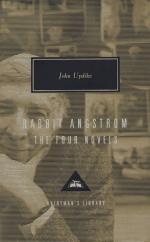|
This section contains 9,376 words (approx. 32 pages at 300 words per page) |

|
SOURCE: “The Rabbit Tetralogy: From Solitude to Society to Solitude Again,” in Modern Fiction Studies, Vol. 37, No. 1, Spring, 1991, pp. 5–24.
In the following essay, Wilson examines elements of social drama, historical consciousness, and tension between the desire for isolation and integration in Updike's Rabbit tetralogy.
Frederick R. Karl in his exhaustive survey of postwar American fiction has little to say about novel sequences because, he claims, in comparison to Britain, there is a “paucity of sequential novels” in America. Our “social expectations” and “our need for movement and escape” militate against novel sequences, which, of necessity, imply “limited options.” The relative scarcity of this form, he argues, is “tied to our optimism, [and] our desire to break from predetermined forms, to free ourselves from the historical past, emerging into that purer atmosphere of pastoral, which promises liberation.” The predominant “predetermined form” from which American writers have attempted to liberate...
|
This section contains 9,376 words (approx. 32 pages at 300 words per page) |

|


